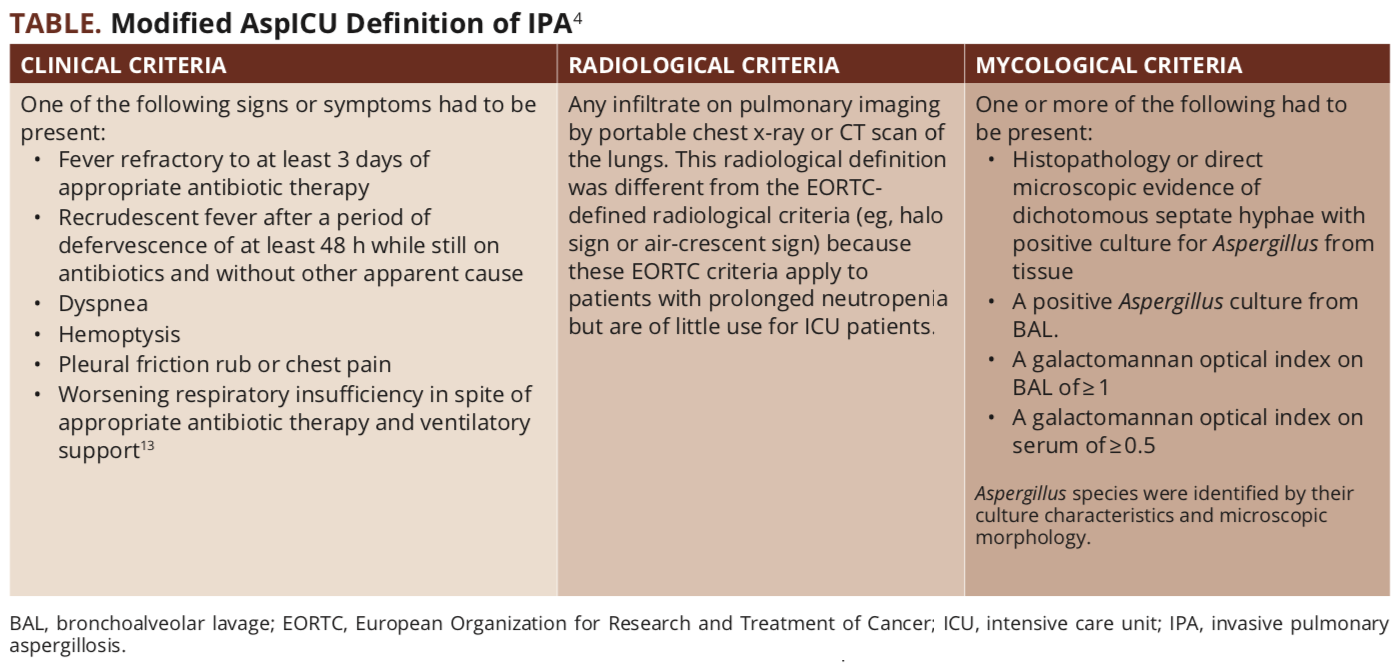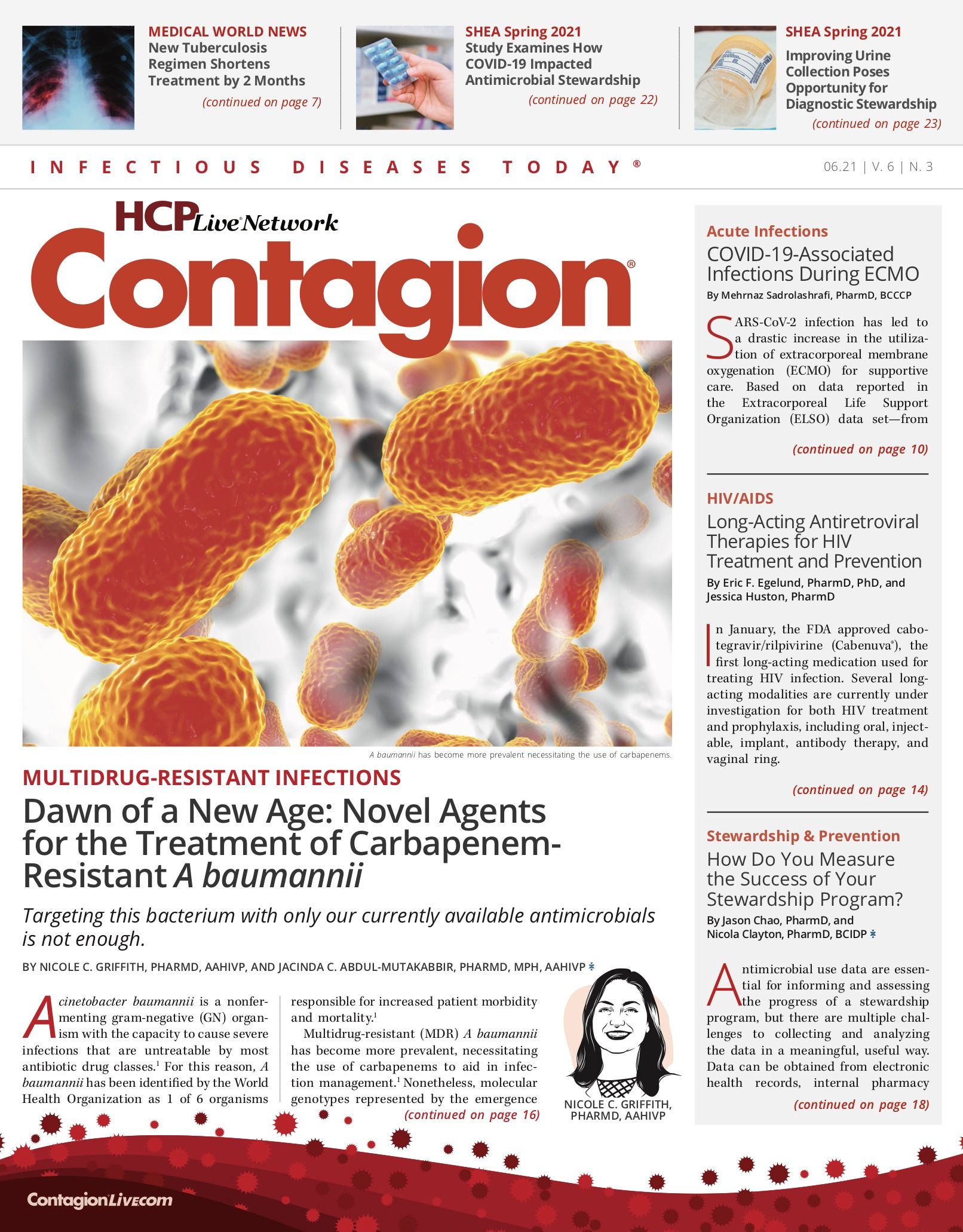COVID-19–Associated Fungal Infections During EMCO: Review of Epidemiology, Diagnosis, and Pharmacotherapy
Examining pharmacological management in COVID-19 patients with ARDS requiring antifungal therapy during extracorporeal life support.
SARS-CoV-2 infection has led to a drastic increase in the utilization of extracorporeal membrane oxygenation (ECMO) for supportive care. Based on data reported in the Extracorporeal Life Support Organization (ELSO) data set—from the start of the pandemic in North America through April 2021—more than 4000 patients were initiated on ECMO, with a reported 50% in-hospital mortality rate.1 The median duration of ECMO support in the most recent ELSO publication was 13.9 days (interquartile range, 7.8-23.3).2 The longer duration of ECMO support begs the question: Are these patients at higher risk of nosocomial infections compared to other critically ill patients?
Potential reasons for increased nosocomial infections in critically ill patients with COVID-19 include3,4:
- Routine use of steroids for COVID-19 acute respiratory distress syndrome (ARDS) based on results from the RECOVERY trial (NCT04381936).
- Use of interleukin 6 receptor antagonists based on REMAP-CAP trial (NCT02735707) investigators.
- Prolonged duration of supportive care (eg, mechanical ventilation, central lines) and increased utilization of empiric broad-spectrum antimicrobial.
Per COVID-19 Real-Time Learning Network, the current data indicate less than 10% rates of bacterial coinfections in patients with the diagnosis of COVID-19 upon presentation. However, with prolonged duration of hospitalization or mechanical ventilation, patients are prone to acquiring nosocomial bacterial and fungal infections. Despite various case series, the epidemiology of COVID-19–associated pulmonary aspergillosis (CAPA) and other fungal coinfections in COVID-19 is not known. The primary focus of this article is to review the diagnosis of fungal infections in population of COVID-19 patients with ARDS requiring support from ECMO and comparing it to the previously published data on its incidence and diagnosis in other viral infections such as Influenza-related ARDS. The secondary focus of this article is to review the published data on pharmacokinetics and pharmacodynamics (PK/PD) of antifungal dosing in ECMO.
Data are lacking in studying the epidemiology of fungal infection in the subpopulation of critically ill patients on ECMO, including the type of ECMO support and variable criteria for clinical diagnosis of invasive fungal infections, which makes the application of these data to clinical practice difficult.
To study the prevalence of fungal infections in ECMO, we should first review its incidence in critically ill patients regardless of their ECMO status.
Aspergillus and Candida Infections in ECMO
Candida and Aspergillus are 2 commonly isolated fungi among critically ill patients.5 Schauwvlieghe and colleagues6reported retrospective data on a cohort of mixed immunocompromised and nonimmunocompromised intensive care unit (ICU) patients to identify risk factors for invasive pulmonary aspergillosis (IPA) among polymerase chain reaction–positive influenza A/B patients (n=432) vs patients with severe community-acquired pneumonia as a comparator group (n=321). The diagnosis of IPA was made based on the presence of clinical, radiological, and mycological criteria (Table 1).6

In the subgroup analysis, 12% of patients in the influenza cohort were on ECMO. Within the ECMO subgroup, 19% were diagnosed with IPA. In this cohort, influenza was reported as an independent risk factor for IPA. The study reported a high prevalence of bronchoalveolar lavage (BAL) sampling in approximately half of the influenza cohort (n=233), in which only 60% of the BAL samples were tested for the presence of galactomannan (GM).

To study if prevalence IPA is also applicable to patients with the diagnosis of COVID-19, Lahmer and colleagues recently published the results of the first randomized, controlled trial to study the prevalence of IPA in patients with severe COVID-19 pneumonia (AspCOVID-19 study).7 Based on anecdotal reports on an increased rate of IPA in patients with a diagnosis of COVID-19 and prior reports during the hemagglutinin type 1 and neuraminidase type 1 influenza pandemic, the authors utilized a modified AspICU algorithm for identifying patients with IPA and risk factors associated with this diagnosis. Figure 1 reviews the standardized diagnostic algorithm the AspCOVID-19 investigators utilized for screening and diagnosis of IPA.
Patients were screened for CAPA until extubation. Patients with the diagnosis of CAPA (positive GM antigen from respiratory and/or serum blood) continued to be followed for 28 days.
A total of 32 patients were included in the final analysis of this study, which found no difference in IPA between COVID-19 and the severe influenza-pneumonia groups.
In a published ELSO registry data set from 2006 to 2016 (including both venoarterial ECMO and venovenous ECMO), solid organ transplant, mechanical ventilation, and influenza infection were found to be risk factors for aspergillosis, and renal replacement therapy and sepsis were independently associated with an increased risk of Candida bloodstream infection (C-BSI).8 In this cohort of patients, 10.8% were found to have fungal infection/colonization, 1.3% Aspergillus, and 1.2% C-BSI. This study reported its findings in a retrospective data set from cultures collected at the discretion of the clinicians rather than a protocolized approach (collecting cultures and conducting bronchoscopy or sending biomarkers when an infection is suspected). Although this study may underestimate the actual prevalence of IPA and/or Candida infections, the diagnostic algorithm for IPA proposed by Schauwvlieghe and colleagues6 may lead to inflating the number of actual patients with this diagnosis, secondary to overtesting and possible false-positive diagnoses.
The balance between overtesting and risk stratification based on the patient’s baseline risk factors for C-BSI and IPA needs to be better studied. Future prospective studies are needed to guide clinicians on empiric treatment without waiting for positive cultures versus conducting appropriate diagnostic imaging and microbiological studies first.
Choice of Antifungal Agent While on ECMO for CAPA/C-BSI
Drug pharmacokinetics (PK) may be altered in ECMO due to various factors such as drug sequestration in the ECMO circuit, increased volume of distribution, and altered clearance (organ dysfunction and/or need for continuous renal replacement therapy).9
If the diagnosis of CAPA/C-BSI is confirmed or highly suspected, timely initiation of antifungal therapy is prudent, as these infections have been associated with an increased rate of mortality and length of hospital stay.10
Per the 2020 European Excellence Center for Medical Mycology/International Society for Human and Animal Mycology consensus criteria for research and clinical guidance, voriconazole or isavuconazole is recommended as a first-line treatment option for CAPA.11 This guideline recommends initiating liposomal amphotericin B in cases of azole resistance in CAPA.
Per Infectious Diseases Society of America guidelines, an echinocandin is the recommended first-line therapy for C-BSI in critically ill patients, which can be later deescalated to an azole based on the isolate susceptibility.12 Liposomal amphotericin B is recommended in case of suspected/confirmed azole resistance.
Table 2. PK Studies in ECMO for Various Antifungal Agents13-22
Table 2Mehrnaz Sadrolashrafi, PharmD, BCCCP, is a critical care pharmacist in the medical intensive care unit at Beth Israel Deaconess Medical Center in Boston, Massachusetts. Her clinical interests include septic shock, antimicrobial stewardship in intensive care unit, and drug dosing in ECMO.
References
- Full COVID-19 Registry Dashboard, ECMO Registry of the Extracorporeal Life Support Organization (ELSO). https://www.elso.org/Registry/FullCOVID19RegistryDashboard.aspx, Accessed April 10, 2021
- Barbaro RP, MacLaren G, Boonstra PS, et al; Extracorporeal Life Support Organization. Extracorporeal membrane oxygenation support in COVID-19: an international cohort study of the Extracorporeal Life Support Organization registry. Lancet. 2020;396(10257):1071-1078. doi:10.1016/S0140-6736(20)32008-0
- RECOVERY Collaborative Group; Horby P, Lim WS, Emberson JR, et al. Dexamethasone in hospitalized patients with COVID-19. N Engl J Med. 2021;384(8):693-704. doi:10.1056/NEJMoa2021436
- REMAP-CAP Investigators; Gordon AC, Mouncey PR, Al-Beidh F, et al. Interleukin-6 receptor antagonists in critically ill patients with COVID-19. N Engl J Med. 2021;384(16):1491-1502. doi:10.1056/NEJMoa2100433
- Paramythiotou E, Frantzeskaki F, Flevari A, Armaganidis A, Dimopoulos G. Invasive fungal infections in the ICU: how to approach, how to treat. Molecules. 2014;19(1):1085-1119. doi:10.3390/molecules19011085
- Schauwvlieghe AFAD, Rijnders BJA, Philips N, et al; Dutch-Belgian Mycosis study group. Invasive aspergillosis in patients admitted to the intensive care unit with severe influenza: a retrospective cohort study. Lancet Respir Med. 2018;6(10):782-792.doi:10.1016/S2213-2600(18)30274-1
- Lahmer T, Kriescher S, Herner A, et al. Invasive pulmonary aspergillosis in critically ill patients with severe COVID-19 pneumonia: results from the prospective AspCOVID-19 study. PLoS One. 2021;16(3):e0238825. doi:10.1371/journal.pone.0238825
- Cavayas YA, Yusuff H, Porter R. Fungal infections in adult patients on extracorporeal life support. Crit Care. 2018;22(1):98. doi:10.1186/s13054-018-2023-z
- Hahn J, Choi JH, Chang MJ. Pharmacokinetic changes of antibiotic, antiviral, antituberculosis and antifungal agents during extracorporeal membrane oxygenation in critically ill adult patients. J Clin Pharm Ther. 2017;42(6):661-671. doi:10.1111/jcpt.12636
- Kett DH, Azoulay E, Echeverria PM, et al; Extended Prevalence of Infection in ICU Study (EPIC II) Group of Investigators.Candida bloodstream infections in intensive care units: analysis of the extended prevalence of infection in intensive care unit study. Crit Care Med. 2011;39(4):665-670. doi:10.1097/CCM.0b013e318206c1ca
- Koehler P, Bassetti M, Chakrabarti A, et al; European Confederation of Medical Mycology, International Society for Human Animal Mycology, Asia Fungal Working Group, et al. Defining and managing COVID-19-associated pulmonary aspergillosis: the 2020 ECMM/ISHAM consensus criteria for research and clinical guidance. Lancet Infect Dis. Published online December 14, 2020. doi:10.1016/S1473-3099(20)30847-1
- Pappas PG, Kauffman CA, Andes DR, et al. Clinical practice guideline for the management of candidiasis: 2016 update by the Infectious Diseases Society of America. Clin Infect Dis. 2016;62(4):e1-e50. doi:10.1093/cid/civ933
- Schauwvlieghe AFAD, Rijnders BJA, Philips N, et al; Dutch-Belgian Mycosis study group. Invasive aspergillosis in patients admitted to the intensive care unit with severe influenza: a retrospective cohort study. Lancet Respir Med. 2018;6(10):782-792. doi:10.1016/S2213-2600(18)30274-1
- Raffaeli G, Cavallaro G, Allegaert K, et al. Sequestration of voriconazole and vancomycin into contemporary extracorporeal membrane oxygenation circuits: an in vitro study. Front Pediatr. 2020;8:468. doi:10.3389/fped.2020.00468
- Cies JJ, Moore WS 2nd, Giliam N, et al. Oxygenator impact on voriconazole in extracorporeal membrane oxygenation circuits. Perfusion. 2020;35(6):529-533. doi:10.1177/0267659120937906
- Mathieu A, Thiboutot Z, Ferreira V, et al. Voriconazole sequestration during extracorporeal membrane oxygenation for invasive lung aspergillosis: a case report. ASAIO J. Published online March 29, 2021. doi:10.1097/MAT.0000000000001427
- Peterson EL, Chittick PJ, Richardson CL. Decreasing voriconazole requirement in a patient after extracorporeal membrane oxygenation discontinuation: a case report. Transpl Infect Dis. Published online December 14, 2020. doi:10.1111/tid.13545
- Zhao Y, Seelhammer TG, Barreto EF, Wilson JW. Altered pharmacokinetics and dosing of liposomal amphotericin B and isavuconazole during extracorporeal membrane oxygenation. Pharmacotherapy. 2020;40(1):89-95. doi:10.1002/phar.2348
- Bellmann R, Smuszkiewicz P. Pharmacokinetics of antifungal drugs: practical implications for optimized treatment of patients. Infection. 2017;45(6):737-779. doi:10.1007/s15010-017-1042-z
- Watt KM, Cohen-Wolkowiez M, Williams DC, et al. Antifungal extraction by the extracorporeal membrane oxygenation circuit. J Extra Corpor Technol. 2017;49(3):150-159.
- Van Daele R, Brüggemann RJ, Dreesen E, et al. Pharmacokinetics and target attainment of intravenous posaconazole in critically ill patients during extracorporeal membrane oxygenation. J Antimicrob Chemother. 2021;76(5):1234-1241. doi:10.1093/jac/dkab012
- Wang Q, Zhang Z, Liu D, et al. Population pharmacokinetics of caspofungin among extracorporeal membrane oxygenation patients during the postoperative period of lung transplantation. Antimicrob Agents Chemother. 2020;64(11):e00687-20. doi:10.1128/AAC.00687-20
- López-Sánchez M, Moreno-Puigdollers I, Rubio-López MI, Zarragoikoetxea-Jauregui I, Vicente-Guillén R, Argente-Navarro MP. Pharmacokinetics of micafungin in patients treated with extracorporeal membrane oxygenation: an observational prospective study. Rev Bras Ter Intensiva. 2020;32(2):277-283. doi:10.5935/0103-507x.20200044

